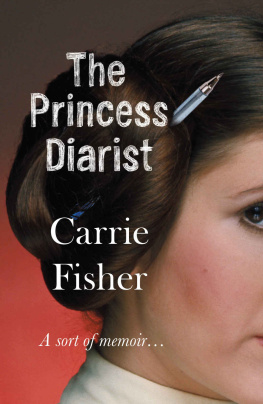Fisher - The Weird and the Eerie
Here you can read online Fisher - The Weird and the Eerie full text of the book (entire story) in english for free. Download pdf and epub, get meaning, cover and reviews about this ebook. year: 2016;2017, publisher: Watkins Media Ltd;Random House Inc, genre: Art. Description of the work, (preface) as well as reviews are available. Best literature library LitArk.com created for fans of good reading and offers a wide selection of genres:
Romance novel
Science fiction
Adventure
Detective
Science
History
Home and family
Prose
Art
Politics
Computer
Non-fiction
Religion
Business
Children
Humor
Choose a favorite category and find really read worthwhile books. Enjoy immersion in the world of imagination, feel the emotions of the characters or learn something new for yourself, make an fascinating discovery.
The Weird and the Eerie: summary, description and annotation
We offer to read an annotation, description, summary or preface (depends on what the author of the book "The Weird and the Eerie" wrote himself). If you haven't found the necessary information about the book — write in the comments, we will try to find it.
The Weird and the Eerie — read online for free the complete book (whole text) full work
Below is the text of the book, divided by pages. System saving the place of the last page read, allows you to conveniently read the book "The Weird and the Eerie" online for free, without having to search again every time where you left off. Put a bookmark, and you can go to the page where you finished reading at any time.
Font size:
Interval:
Bookmark:
THE WEIRD AND THE EERIE
MARK FISHER
The Weird And The Eerie

To Ze, my constant source of support, and the reason there is something here rather than nothing.
Contents
INTRODUCTION
The Weird and the Eerie (Beyond the Unheimlich)
It is odd that it has taken me so long to really reckon with the weird and the eerie. For although the immediate origins of this book lay in fairly recent events, I have been fascinated and haunted by examples of the weird and the eerie for as long as I can remember. Yet I had not really identified the two modes, still less specified their defining features. No doubt this is partly because the major cultural examples of the weird and the eerie are to be found at the edges of genres such as horror and science fiction, and these genre associations have obscured what is specific to the weird and the eerie.
The weird came into focus for me around a decade ago, as the result of two symposia on the work of H.P. Lovecraft at Goldsmiths, University of London; while the eerie became the major subject of On Vanishing Land, the 2013 audio-essay I produced in collaboration with Justin Barton. Appropriately, the eerie crept up on Justin and me; it had not been our original focus, but by the end of the project we found that much of the music, film and fiction that had always haunted us possessed the quality of the eerie.
What the weird and the eerie have in common is a preoccupation with the strange. The strange not the horrific. The allure that the weird and the eerie possess is not captured by the idea that we enjoy what scares us. It has, rather, to do with a fascination for the outside, for that which lies beyond standard perception, cognition and experience. This fascination usually involves a certain apprehension, perhaps even dread but it would be wrong to say that the weird and the eerie are necessarily terrifying. I am not here claiming that the outside is always beneficent. There are more than enough terrors to be found there; but such terrors are not all there is to the outside.
Perhaps my delay in coming round to the weird and the eerie had to do with the spell cast by Freuds concept of the unheimlich. As is well known, the unheimlich has been inadequately translated into English as the uncanny; the word which better captures Freuds sense of the term is the unhomely. The unheimlich is often equated with the weird and the eerie Freuds own essay treats the terms as interchangeable. But the influence of Freuds great essay has meant that the unheimlich has crowded out the other two modes.
The essay on the unheimlich has been highly influential on the study of horror and science fiction perhaps, in the end, more because of Freuds hesitations, conjectures and rejected theses than for the actual definition he provides. The examples of the unheimlich which Freud furnishes doubles, mechanical entities that appear human, prostheses call up a certain kind of disquiet. But Freuds ultimate settling of the enigma of the unheimlich his claim that it can be reduced to castration anxiety is as disappointing as any mediocre genre detectives rote solution to a mystery. What enduringly fascinates is the cluster of concepts that circulate in Freuds essay, and the way in which they often recursively instantiate the very processes to which they refer. Repetition and doubling themselves an uncanny pair which double and repeat each other seem to be at the heart of every "uncanny" phenomena which Freud identifies.
There is certainly something that the weird, the eerie and the unheimlich share. They are all affects, but they are also modes: modes of film and fiction, modes of perception, ultimately, you might even say, modes of being. Even so, they are not quite genres.
Perhaps the most important difference between the unheimlich on the one hand and the weird and the eerie on the other is their treatment of the strange. Freuds unheimlich is about the strange within the familiar, the strangely familiar, the familiar as strange about the way in which the domestic world does not coincide with itself. All of the ambivalences of Freuds psychoanalysis are caught up in this concept. Is it about making the familiar and the familial strange? Or is it about returning the strange to the familiar, the familial? Here we can appreciate the double move inherent to Freudian psychoanalysis: first of all, there is estrangement of many of the common notions about the family; but this is accompanied by a compensatory move, whereby the outside becomes legible in terms of a modernist family drama. Psychoanalysis itself is an unheimlich genre; it is haunted by an outside which it circles around but can never fully acknowledge or affirm. Many commentators have recognised that the essay on the unheimlich itself resembles a tale, with Freud in the role of the Jamesian unreliable narrator. If Freud is an unreliable narrator, why should we accept that his own tale should be classified in terms of the category that his essay proposes? What if, instead, the whole drama of the essay consisted in Freuds attempts continually to contain the phenomena he explores within the remit of the unheimlich?
The folding of the weird and the eerie into the unheimlich is symptomatic of a secular retreat from the outside. The wider predilection for the unheimlich is commensurate with a compulsion towards a certain kind of critique, which operates by always processing the outside through the gaps and impasses of the inside. The weird and the eerie make the opposite move: they allow us to see the inside from the perspective of the outside. As we shall see, the weird is that which does not belong. The weird brings to the familiar something which ordinarily lies beyond it, and which cannot be reconciled with the homely (even as its negation). The form that is perhaps most appropriate to the weird is montage the conjoining of two or more things which do not belong together. Hence the predilection within surrealism for the weird, which understood the unconscious as a montage-machine, a generator of weird juxtapositions. Hence also the reason that Jacques Lacan rising to the challenge posed by surrealism and the rest of aesthetic modernism could move towards a weird psychoanalysis, in which the death drive, dreams and the unconscious become untethered from any naturalisation or sense of homeliness.
At first glance, the eerie might seem to be closer to the unheimlich than to the weird. Yet, like the weird, the eerie is also fundamentally to do with the outside, and here we can understand the outside in a straightforwardly empirical as well as a more abstract transcendental sense. A sense of the eerie seldom clings to enclosed and inhabited domestic spaces; we find the eerie more readily in landscapes partially emptied of the human. What happened to produce these ruins, this disappearance? What kind of entity was involved? What kind of thing was it that emitted such an eerie cry? As we can see from these examples, the eerie is fundamentally tied up with questions of agency. What kind of agent is acting here? Is there an agent at all? These questions can be posed in a psychoanalytic register if we are not who we think we are, what are we? but they also apply to the forces governing capitalist society. Capital is at every level an eerie entity: conjured out of nothing, capital nevertheless exerts more influence than any allegedly substantial entity.
The metaphysical scandal of capital brings us to the broader question of the agency of the immaterial and the inanimate: the agency of minerals and landscape for authors like Nigel Kneale and Alan Garner, and the way that we ourselves are caught up in the rhythms, pulsions and patternings of non-human forces. There is no inside except as a folding of the outside; the mirror cracks, I am an other, and I always was. The shudder here is the shudder of the eerie, not of the
Next pageFont size:
Interval:
Bookmark:
Similar books «The Weird and the Eerie»
Look at similar books to The Weird and the Eerie. We have selected literature similar in name and meaning in the hope of providing readers with more options to find new, interesting, not yet read works.
Discussion, reviews of the book The Weird and the Eerie and just readers' own opinions. Leave your comments, write what you think about the work, its meaning or the main characters. Specify what exactly you liked and what you didn't like, and why you think so.
















